Waukesha Christmas-Parade Trial, Day Eleven
Anastasia Katz, American Renaissance, October 21, 2022
On Thursday, October 20, the state called Detective Thomas Casey back to the stand. He was controlling traffic on the day Darrell Brooks drove his car through the Christmas parade, and was assigned as lead detective on the case. He explained that in this incident, the official number of victims — 6 dead and 54 injured — includes only those people Darrell Brooks hit and who went to the hospital. It does not include other people he hit, nor people who were hurt running away.
The jury looked at a photo of Virginia “Ginny” Sorenson, 79, carrying the “Dancing Grannies” banner at the parade. She was wearing a black hat with a snowflake pattern and a white parka. Mrs. Sorenson was one of the six killed. The jury was then shown a photo of the red SUV Mr. Brooks used in the attack, taken after he abandoned it. The snowflake hat and the hood from Mrs. Sorenson’s white parka were stuck under the windshield wipers.
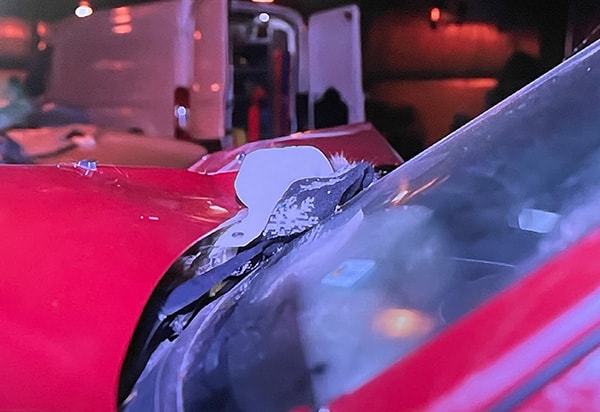
Detective Casey used the word “attack” in his testimony and Mr. Brooks objected, saying it was “a disparaging remark.” The judge upheld his objection and instructed the witness to “simply describe what he is seeing without further characterizing it.”
The jury was shown a photo of the red SUV hitting members of a high school band, which showed the license plate, ADP 9256. The detective compared that to an image from Darrell Brooks’s Facebook page, which shows him standing next to the vehicle, which has the same plate number.
There was a lot of video evidence the state did not show the jury. District Attorney Susan Opper asked the detective, “To your knowledge, did any video ever show a different person behind the driver’s wheel of that SUV?”
Det. Casey said, “I have never seen anyone driving the vehicle except the defendant.” He also never saw the SUV slowing or stopping on the parade route, and never saw the driver get out to check on anyone he hit.
Another police officer had given Det. Casey the car key found on Mr. Brooks when he was arrested. The car fit the SUV.
The defendant, who chose to waive his right to a lawyer and is defending himself, has been objecting when someone uses his name. Det. Casey explained how he verified that the name of the man police arrested was Darrell Brooks: “When a person is taken into custody, we take fingerprints. We check that against other records that are kept by the state. Those fingerprints matched Darrell Brooks. I have also spoken to three women that he has children with; they verified that that is the name he has always gone by. I had also spoken to his mother, who states that that is the name he has gone by, always.”
The charges against Darrell Brooks include bail-jumping. The jury was shown a copy of a bail bond for Darrell Edward Brooks. On the date of the Christmas parade, he was out on bail for several felonies. One of the conditions of bail is that the defendant commit no crimes. Another bond dated listed four felonies and had the same condition.
Mr. Brooks’s mother, Dawn Woods, gave police a video with a time stamp showing it was taken three hours before the parade attack. Detective Casey said Miss Woods had been cooperative and turned over the video the night of the incident. It shows Darrell Brooks, dressed in the red T-shirt and jeans he was wearing at the time of his arrest, getting into the red Ford Escape and driving away. There was no damage to the car when Mr. Brooks left his mother’s house; after he drove through the parade, the front was heavily damaged.
During his cross, Mr. Brooks pointed out that the Facebook image of him with the car and visible license plate was from a video, and showed him only from behind. He asked Det. Casey how he was able to identify the man in the photo, since his face was not visible.
“I know, from looking at the entire video, that it is you.”
The defendant was angry that the police had spoken to the mothers of his children. The detective had even made a trip to Iowa to talk to one of them. Mr. Brooks asked why he did that when the suspect had been identified with fingerprints. It was for thoroughness. Mr. Brooks asked many questions about whether anyone had interviewed his 7-year-old child, but there were relevance objections. The child was not interviewed, and the judge made Mr. Brooks move on.
Mr. Brooks used his car horn only when he first entered the parade route. Detective Casey had been there and tried to stop Mr. Brooks from driving into the parade. In an effort to claim he tried to warn people to get out of the way, Mr. Brooks asked if the detective knew why the driver was beeping the horn. The detective said, “I imagine the driver was angry and wanted to get through the crowd.”
On redirect, the DA took advantage of the fact that Mr. Brooks asked about the Facebook screenshot that showed the license plate but not his face. This opened the door for the prosecution to play the entire video to prove the person was Mr. Brooks. This was a music video, but was played with no sound. Mr. Brooks said he wanted to hear it with sound, but was unhappy it was played at all. He said he didn’t know the state had the video, and kept saying, “This is mind boggling.”
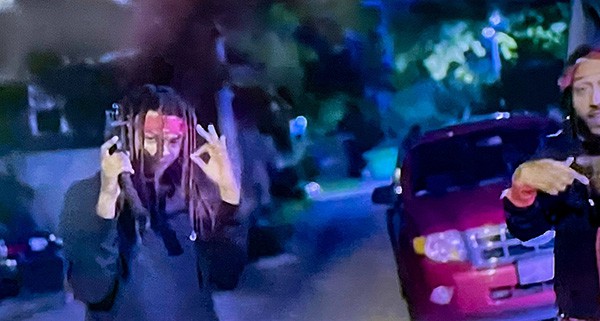
Scene from Darrell Brooks’ music video.
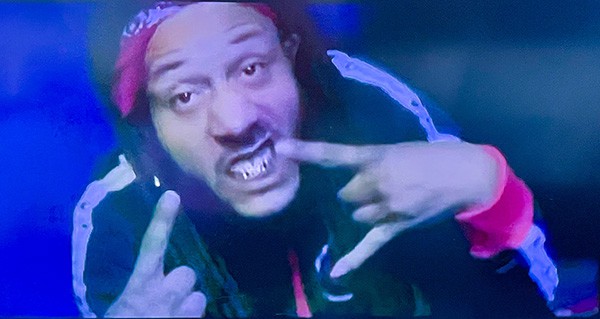
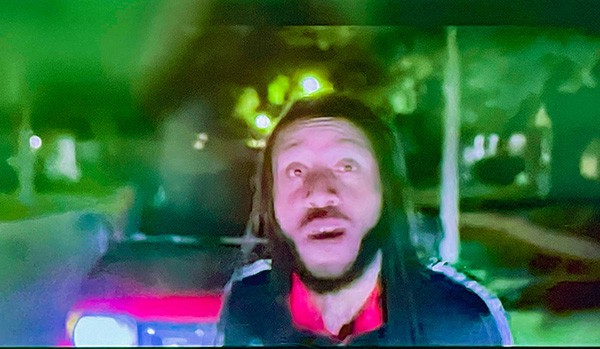
DA Susan Opper said that the video was included in discovery that was sent to the public defender’s office. Mr. Brooks must not have gone through all the discovery materials. That would have been a big job for one person, but it was his choice to fire the public defender. Mr. Brooks complained angrily that the state used his music video “out of the blue, at the last minute.”
Outside the presence of the jury, DA Opper made a speech about the defendant’s conduct, noting that “this court has been abundantly patient with Mr. Brooks.” “He challenges the court’s authority repeatedly,” she said, and “continues to suggest and impugn the integrity of this court and this prosecution without basis.” Unable to understand a number of legal points the DA made, Mr. Brooks responded, “She just admitted, on the record, that she just made this exhibit up!”
Judge Dorow told the defendant that he has a Constitutional right to testify or not; it’s his choice. If he doesn’t testify, the jury will be instructed that it may not use that against him. Mr. Brooks still had not decided.
The state rested its case.
After lunch, Judge Dorow asked Mr. Brooks if he was ready to give his opening statement, but he stalled, saying he could not find files on witnesses. Then he made a last-ditch effort to stall by saying that subject matter jurisdiction must be proven. The judge informed the jury to disregard that since he was misstating the law. Several days ago, Judge Dorow gave Mr. Brooks a document confirming jurisdiction, which he tore up.
Finally, Mr. Brooks took off his mask and said, “Obviously, I don’t have any rehearsed or prepared speech, so I’m just going to speak from the heart.” He began humbly. He said that for the past year, only one side of the story had been told. “You won’t hear me try to argue facts. The fact is, that this incident was tragic, very tragic. That is not lost on me.”
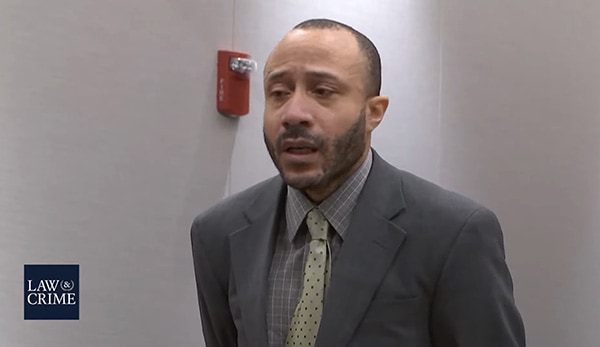
Darrell Brooks giving his opening statement.
In a 10-minute statement, Mr. Brooks did not summarize what any of his witnesses would tell the jury, which is typical for an opening. His plea is not guilty, but he offered no reason why jurors should come to that verdict. He did not deny that he did what he is accused of doing and, surprisingly, did not claim he was not Darrell Brooks.
He said he acted on the spur of the moment: “The evidence will show that this incident was not planned. This incident was not intentional. And this incident was never even thought about.”
He continued: “There’s been a lot of suffering involved in this incident, a lot . . . Obviously, with the families . . . .” He began to cry. “With the community, and with the alleged defendant’s family as well, there’s been a lot of suffering. A lot of misunderstanding.”
“There’s been a lot of words thrown out there . . . . A lot of speculation, a lot of ridicule. Words like demon, words like monster.” His voice broke on “monster” and he wiped his eyes. Tearfully, he said to the jury, “Keep in mind the power that you have . . . . When it’s time for you to make your decision . . . I pray that it’s the right decision. That all the factors are weighed.”
He mentioned that he had been wearing a mask in the courtroom until then, and said he had “reasons” for that. “Now is the time, it’s important for you to see me for who I am. No mask. Who I am. I think this is the moment for that.”
People watching the trial on Court TV saw that “who he is” is a murderer. The reaction on Twitter was unanimous; many accused him of crocodile tears.
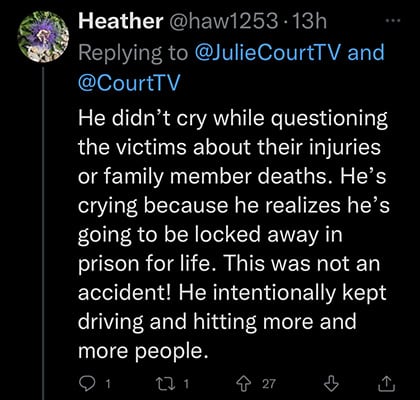
Mr. Brooks ended his statement by saying, “The power’s in your hands to determine for yourselves what truth is. Thank you.” Then he sat down and cried.
The judge asked if he was ready to call a witness. He was still crying, so she asked if he needed a minute. The judge sent the jury out. When it returned, Mr. Brooks was sulky and flustered. He wasn’t sure whom to call to the stand. After the judge told him to begin his case, he said, “The defense would like to call the plaintiff, the state of Wisconsin to the stand.”
The prosecution objected, and the judge sustained. Judge Dorow told him to call his next witness.
Mr. Brooks made a motion to dismiss based on the plaintiff’s failure to appear. The judge said she would take it up outside the presence of the jury.
Mr. Brooks called Nicholas Kirby to the stand. Mr. Kirby, a white man, is friends with Mr. Brooks’ black girlfriend, Erika Patterson. Miss Patterson and their mutual friend, Kori Runkel testified that Mr. Kirby called the police after Mr. Brooks hit Miss Patterson in a park.
It was obvious that Mr. Kirby despises Mr. Brooks. Mr. Brooks’ open-ended questions allowed Mr. Kirby to say, several times, that he had told Miss Patterson not to see Mr. Brooks, because he feared for her safety. He also mentioned that Miss Patterson had shown him Mr. Brooks’s photo and rap sheet.
“You made reference to a Mr. Brooks,” the defendant said, with a puzzled expression. “Who’s that?”
“That would be you,” Mr. Kirby answered, “because that’s your name.”
He said Miss Patterson called him six times, screaming for help, and telling him she was being driven in a red SUV. Mr. Kirby was on the phone with Miss Patterson when he found a police officer and told him that a woman was being assaulted in a vehicle. He told the officer to look for a red SUV with a woman screaming in it.
Asked why he hadn’t given a physical description of Miss Patterson, Mr. Kirby said, “There aren’t many red SUVs with women screaming for help in Waukesha.”
Mr. Brooks probably called Mr. Kirby as a witness because Miss Patterson had testified earlier in the trial that Mr. Kirby told the police that Mr. Brooks had a knife, which he did not. Mr. Kirby said, “That was a miscommunication between me and an officer. I had been knifed earlier that week and had 12 stitches in one hand.” He said he had never said Mr. Brooks had a knife.
Mr. Brooks next called a white woman named Heather Riemer to the stand. She had seen Mr. Brooks driving the wrong way on a one-way street before he drove through the parade. Mr. Brooks got an answer he seemed to like when he asked, “In your opinion, why would a vehicle honk its horn?”
“To alert somebody?”
Mr. Brooks is continuing his defense today. Although he did not know what order to call his witnesses in, he did say that he would be calling his girlfriend Erika Patterson back to the stand.















